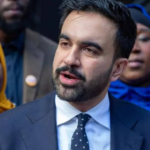The other day, while we were unpacking groceries, my 12-year-old asked, “Wait… can a president just stay president if they don’t want to leave?” She’d overheard something about how President Trump wanted to stay on for a third term and wasn’t sure how it all worked.
I paused and tried to give her a clear answer. No, based on our constitutional limits for the length of the presidency and the 22nd Amendment limiting people to two full elected terms, President Trump could not lawfully stay on for three terms.
Now, as a political science professor, that answer was more at-the-ready for me than it might be for most parents. But for most kids, questions about politics are perfectly reasonable as they try to figure out their world.
These questions don’t always have a perfect or totally known answer, but they’re moments we shouldn’t waste. We need to teach our kids more than just to dread politics, we need to teach them how to do and understand politics.
If I don’t talk to my child about politics, someone else – or something else will. Whether it’s classmates, YouTube or any of the billions of things vying for their attention, kids are absorbing political information all the time. Our job is to help them make sense of it.
We often treat politics like something to shield our children from. We say they’re too young or it’s too contentious. But politics isn’t something that starts at 18. It’s already shaping their lives: in the air they breathe, the schools they attend and the list goes on. Kids live in the world, and that world is governed by systems that transform the choices of people into policies. Pretending otherwise doesn’t protect them; it leaves them unprepared.
That doesn’t mean parents need to launch into lecture mode every time a news story breaks. But it does mean we should make politics safe to talk about at the kitchen table, just like sports, shows or weekend plans.
For many kids, the government feels distant and impersonal. They hear about Congress or the president, but they don’t know who represents them or how to engage. Change that. Look up your local representatives together. Attend a community board meeting. Write a letter to an elected official about something your child cares about – parks, school lunches or animal shelters, and go see the spaces of government together.
These small acts help kids see that government isn’t just something that happens to them – it’s something they can influence. They begin to understand that democracy isn’t a spectator sport. And importantly, they don’t have to wait until they’re 18 to start participating.
Parents often ask me, “When is the right age to start talking to kids about politics?” My response: You already are. Every time you comment on the news, vote, donate, vent or stay silent, you’re sending a message.
Your child is watching, listening and learning.
In my book “How to Raise a Citizen (And Why It’s Up to You to Do It),” I remind readers that our kids will inherit this democracy, however healthy or fractured it may be. We can’t wait for someone else to teach them how it works. We have to step in and show them – even if that means learning more ourselves along the way.
Talking politics with kids doesn’t have to be formal. It can happen while walking the dog or riding to school. The key is to stay open, curious and remember that you don’t need all the answers. You just need to show them how to care, how to learn more, and how to engage with the country they’re growing up in.
So the next time your kid asks about primary elections (hello, NYC), protests, or presidents – don’t deflect. These little conversations are what raise citizens. And that’s exactly what our country needs right now.
Opinion Forum,USA TODAY







